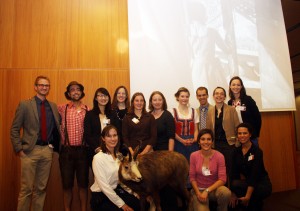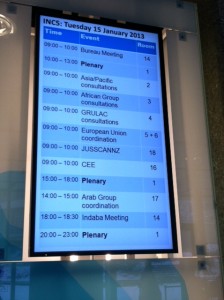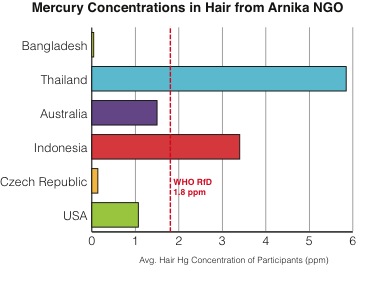by Mark Staples and Danya Rumore
During INC5, we were responsible for the interconnected issues of mercury supply and trade (Article 3), waste (Article 13), and artisanal and small-scale gold mining, or ASGM (Article 9). These articles were introduced in plenary early on and, given disagreement about the text, were quickly sent to the contact group on selected technical articles for revision. It took until mid-afternoon on Friday for the contact group to reach resolution on these topics, but an agreement was reached. Here is a summary of how these issues evolved over the course of the week and an overview of what made it into the agreed-upon treaty text.
Supply, Trade, and Waste
In our previous issue overview blogs on mercury supply and trade and waste, we anticipated that discussions on these issues would focus on 1) whether and how to regulate primary mercury mining operations; 2) the identification of existing stocks of mercury and mercury compound; and 3) the integration of concepts from the Basel Convention and Rotterdam Convention into the mercury treaty.
In terms of primary mercury mining, the biggest breakthrough of the negotiations was an agreement to phase-out existing primary mercury mining operations within 15 years of treaty ratification, despite initial stiff opposition from China, a nation that is currently home to significant mercury mining. Additionally, a ban on new primary mercury mining was agreed upon. Some countries with mercury deposits but no existing primary mining operations requested financial compensation for foregone resource development resulting from the ban on new mining. Thankfully, the contact group Co-Chair, Donald Hannah, helped avoid this potential sticking point by making clear that discussion of such compensation was beyond the scope of the technical working group. Importantly, the ban on new mining and phase-out existing mining will help prevent the continued release of mercury from lithosphere into the earth’s atmosphere, oceans, and soil.
It was agreed upon at INC4 that all parties must quantify secondary sources of mercury and mercury compounds by taking inventory of “stocks” and “supply-generating stocks”. However, the thresholds sizes for the accounting of these sources were not defined in the draft treaty text put together by the Chair, and we expected that this would be a point of contention during the final negotiations. Surprisingly, the contact group quickly settled upon thresholds of 50 metric tons for individual stocks and 10 metric tons per year of supply-generating stocks. While the question of threshold sizes was easily resolved, the question of whether mercury compounds should be included in the clauses of article 3 was the source of much debate. Resistance came primarily from the American delegates, who did not want mercury compounds to be included. However, after much debate, it was decided that mercury compounds will be included.
Discussion around supply, trade, and waste also focused on whether and how to include a “Prior Informed Consent” (PIC) mechanism, similar to that included in the Rotterdam Convention, for mercury import and export. From the contact group discussions, it was clear that PIC is important to developing nations, especially those from the African Group and Group of Latin America and Caribbean Countries (GRULAC). In the end, the contact group agreed upon a PIC mechanism that allows states to submit standing consent, indicating PIC of all mercury imports until further notice, to the Secretariat. This compromise is designed to stem the flow of illicit or unwanted mercury trade while, at the same time, minimizing the administrative burden of PIC.
Finally, Article 12 of the agreed upon treaty text mandates that the trans-boundary movements of mercury waste must comply with the terms of the Basel Convention.
Artisanal and Small-Scale Gold Mining
UNEP’s Global Mercury Assessment 2013 indicates that ASGM is now the largest source of anthropogenic mercury emissions. As such, we expected significant negotiation over whether and how to regulate the import and export of mercury for ASGM, and possibly some discussion over the eventual phase-out of ASGM.
However, ASGM is a particularly difficult issue to address in a multi-lateral setting like INC5. Beyond the environmental issues, which are both local and global in nature, ASGM is tied to the economic interests of many developing nations. As a result, there are serious trade-offs between the social and economic benefits and the health and environmental impacts of ASGM, and these trade-offs need to be considered when making an ASGM policy.
At INC5, Article 9 on ASGM was discussed but was not altered dramatically from the Chair’s proposed text. No special restrictions were placed on the use of imported mercury for ASGM, and no phase-out date was included in the draft treaty text. The only significant change to the Chair’s proposed text was the addition of some relatively weak wording in Annex E (which concerns national action plan requirements for ASGM) indicating that nations must develop “strategies for managing trade and preventing diversion of mercury” for ASGM.
Summary
Although supply, trade, waste, and ASGM are seemingly separate issues, it worked surprisingly well for a single contact group to work toward agreement on these topics along with issues related to products and processes. By discussing all of these concerns in detail in the same forum, delegates were able to trade across issues to develop a text that, in aggregate, was acceptable to everyone. As Lawrence Susskind says in his blog on good negotiation strategy, working across issues to create package solutions is important for mutual gains outcomes.
We can’t wait to see if the final versions of Articles 3, 9, and 13 will stand up to their next test: the signing in Minamata!




